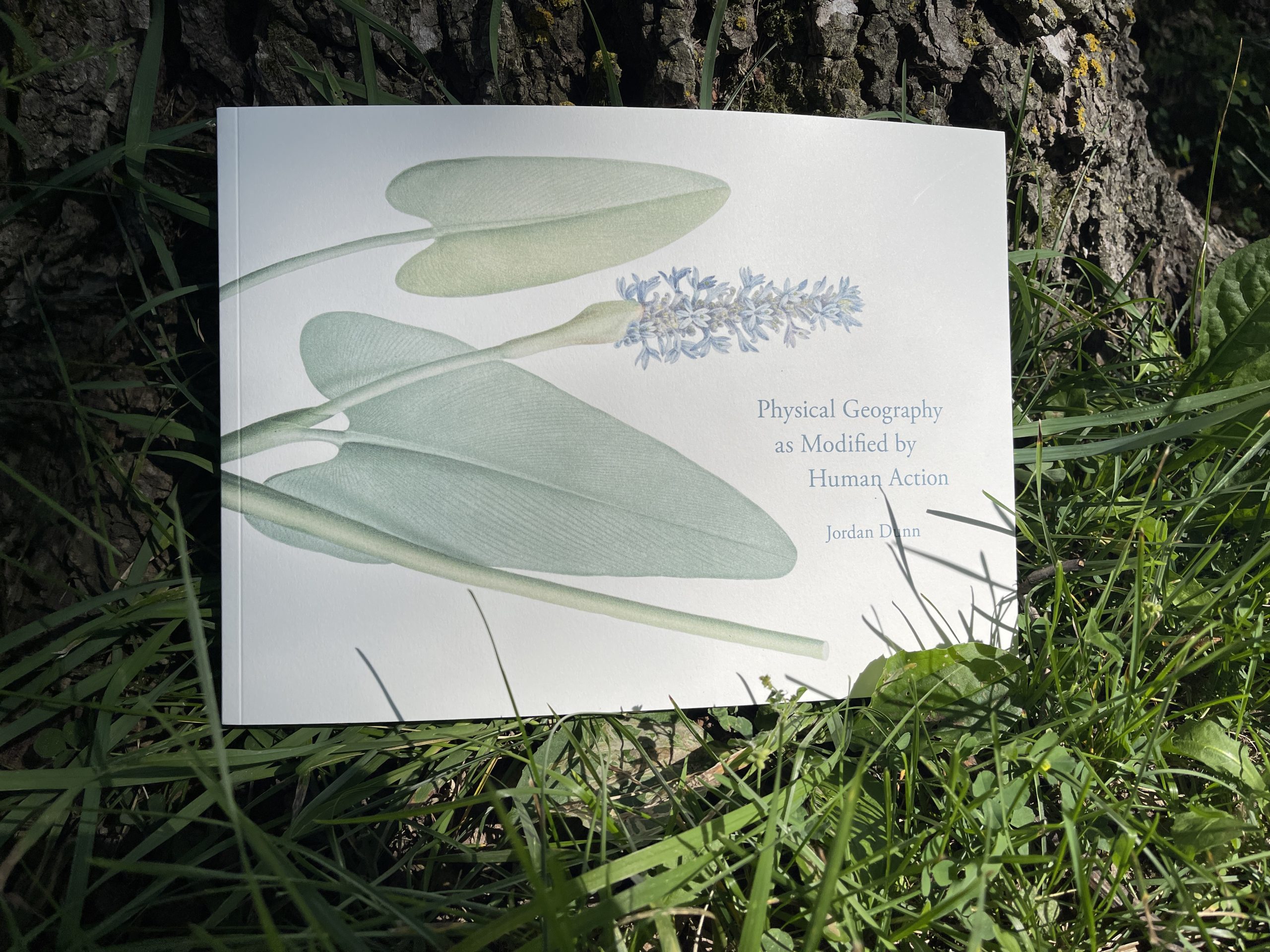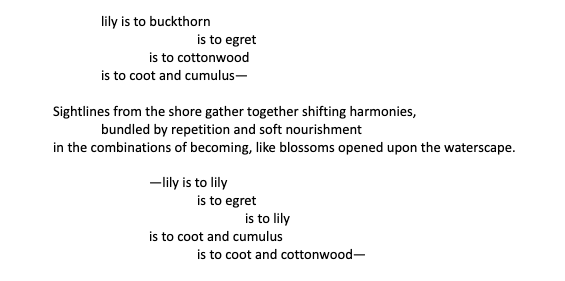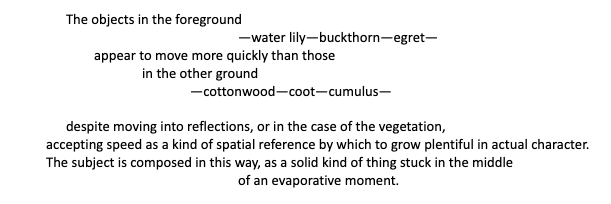by KYLAN RICE

Jordan Dunn, Physical Geography as Modified by Human Action (Partly Press, 2022), pp. 84.
In a chapter on the lumber industry in Man and Nature, Or, Physical Geography as Modified by Human Action (1864), the American conservationist George Perkins Marsh observes that “a fire may render the declivity of a mountain unproductive for a century.” He illustrates his point with a footnote recalling a fierce manmade fire around the turn of the nineteenth century that burned so hot it consumed “a dense primeval forest” as well as the “mould” or soil beneath it. Even the bedrock was cracked and partially “distintegrated” by the blaze. Jordan Dunn quotes this anecdote in Physical Geography as Modified by Human Action (2022), a new book of poems and found texts that owes its title to Marsh. In Dunn’s book, Marsh’s prose footnote is lineated and broken into stanzas that curve to enclose a paragraph composed of a mash-up of original language as well as language found in one of Marsh’s earlier chapters. The passage relates how lichen grows on scorched rock and facilitates the deposition of new dirt: it “detach[es] the mineral richness” and “decompos[es] the subjacent rock” in a process that supplements the “decay of leaves and wood on the surface” and restores, over the course of a hundred years, a “stratum of soil thick enough to support a full-grown forest.”
Dunn’s poetry, like lichen, is lithoclastic. It is a composite organism that grows across the surfaces of other texts and breaks them down in an effort to lay down a thin layer for “second growth”—growth in the aftermath of devestation, specifically the long history of environmental destruction sanctioned by enlightenment ideals and the concomitant rationalization of the land. The work described in Dunn’s book is the work of “foraging substrates,” and frequently those substrates are the pages of other books, which the poet mulches and decomposes in the hope of building up the ground, a place to stand and belong. The experience of reading Physical Geography is like coming across a strip mine or a muddy swath of cleared land after heavy rain: everything is wrecked and upturned, but there’s a latent vitality in the scree, the puddles, the silt, which is veined and lobed and channeled by streamlets of runoff. Henry David Thoreau loved to observe these veins in the sandbanks shoring up the railroad. The phenomenon reminded him that there is a basic impulse even in the dirt toward vascularity. In the ruderal sludge formed by digging, trenching, and laying rail for the transport of double-stacked intermodal boxes, there’s an image of a leaf, and in the leaf, an image of a net of human nerves and arteries. In the thin deposit made by making (by milling, fabricating, shipping), an image of the body appears. The human is that thinness, that thinning and washing away and fanning out into an eroded floodplain. Thinned by our own hand (our own making), we become porous, like a membrane, a translucent layer made more sensitive to devastation by the destructions we have wrought.
In certain respects, Dunn is a destroyer (as are we all). He is conscious and astutely critical of the way in which his work is continuous with histories of destruction. He follows after Thoreau and Emerson in the sense that he is interested in the poet as a surveyor, an individual who is, in actual practice, part of the process of demarcating a property for subsequent development and subdevelopment. Dunn’s book—beautifully printed by Partly Press on pages wider than they are tall—is a meditation on “poetry composed within the landscape page confinement,” which is reminiscent of the “landscape photograph” as a “rectangular framing device.” He is interested, in other words, in the poem as a landscape—or rather, the representation or surveyor’s map of a landscape, its properties meticulously named and described and catalogued and thereby subdued. Partly Press is dedicated to the “radically specific landscape poem”—and Dunn’s book exemplifies this mission. But specificity is conventionally the outcome of empirical observation and measurement and precise reproduction. To represent the wood duck in all its feathered gloss and luster, Audubon first has to hunt and kill it and examine it up close as nature morte.
Dunn articulates the problem of the surveyor, the map-maker (and, by extension, the traditional landscape poet): “unlike settlers, surveyors are capable of separating their experiences of phenomena from their skilled knowledge sets describing / these phenomena, which are constructed from bodiless fabric, and serve as drivers of manipulation.” The powers of separation or abstraction available to the transient, impartial surveyor do not necessarily make him more virtuous than the settler, much maligned but at least emplaced. Dunn essentially describes the creation of metadata—the informationalization of a landscape—which is detachable and made available for “manipulation”—for zoning, parceling, the gridding of law and language over land. His characterization of this web of information as a “bodiless fabric” is important, since throughout Physical Geography the poet is concerned with “immateriality,” specifically the immateriality that Emerson writes about when he observes a “property in the horizon which no man has but he whose eye can integrate all the parts, that is, the poet.” This property is immaterial in the sense it cannot be bought and sold. It is, in fact, a perception of the total relation between things, the ability to hear the landscape rhyming with itself, the way that channels in a sandbank rhyme with veins in a leaf. The perception of likeness or similarity requires an ability to abstract or induce a general law. Thus the poet’s special claim to bodiless realms of ideality. A poem rhymes and integrates, and in the process plots a map that reimagines the properties of the land as essentially fungible or subject to exchange at the level of essence.
Dunn observes this process:

An observer stands on a shoreline and surveys a lily, a buckthorn, a cottonwood, a coot, and a cumulus cloud. They converge in her field of vision; they form a total picture and become irreducibly related to each other—entangled, even—by the mere act of looking at them. To look is to assert a “shifting harmony,” the resonant shared belonging of lily and buckthorn in the moment of their subjective coincidence. Dunn registers this coincidence using the language of logic and ratiocination. There is a ratio between lily and buckthorn, between buckthorn and egret, between egret and cottonwood. Joined as if by a colon, they flow spongily (fungibly) into each other and interpenetrate, if not equivalent, then radically related, not so much in themselves as in the eyes of the surveyor as rationalizing observer.
As seductive as this harmony might be, the landscape always exceeds the rhyme and reason—the logic of relation—imposed upon it by the limited individual observer, who is necessarily transient. The observer or surveyor is on the move—a saunterer, a water-strider, a skimmer through place as well as time. As a result, the view changes, the relations recombine, like shifts in stage scenery. As I walk, objects in the far distance appear to move away from me at a slower pace than the objects on the immediate border of my path:

Here, Dunn indicates that the subject is “composed” in the slipstream between the different depths of field. The subject is a “solid kind of thing,” sure, but that solidity is proved and ultimately shaped and eaten away by the flux that flows around it, like a boulder in the midst of a river. The viewer imposes a sense of interrelation on a landscape and then the vastness of the space (its ruggedness, its unevenness, its jaggedness; that is to say, its variability as a terrain) proceeds to undermine that sense. As Dunn observes, “each locatable place inhabits another loctable place, / like distempered views of surfaces violating internal harmonies by clouding the precision of their practicality.” In other words, the attempt to assert location (i.e., the attempt to erect an edifice of metadata, of cognizable order) must succumb to spatial relativity and the inevitable limits of observation.
A true landscape poet—and Dunn is eminently one of these—does not simply represent the land, but also shows how the land subverts or subducts its representation. The value of a representation begins to deteriorate as soon as it is codified and rendered portable beyond its contexts. As Dunn reminds us, “in some instances, the observers were no longer within the reach of inquiry, and of course their tables of the wind were of no value.” All tables—all charts and graphs and maps—are tables of the wind, made as if of wind themselves. As much as Dunn limns the problems associated with “radically specific” observation as it has been used to map and order and subsequently exploit the land, he insists that observation is only specific when it “accomplishes itself through a radicalization of context.” That is to say, observation in its truest or purest sense is not portable. It is not “detachable.” It is irrevocably imbricated (“radicalized” or “rooted,” the meaning of radix) in the place that it occurs. And because it is context-specific, it is also highly volatile, even “evaporative,” for the observer can’t stay long. Indeed, all inquiry is “superficial inquiry.” A thin deposition subject to erosion in heavy rains.
Physical Geography is a book of strata—a book of thin surfaces. A book of pages, in other words. Each page carries passing observations (regarding the “deliciousness of evening and the marsh wren’s satisfaction”) that are necessarily superficial but gain in beauty and specificity the more emphatically they lay claim to their superficiality, their transient context-dependency. To read is to deposit one page on top of another, surface over surface. In the logic of Dunn’s project, the deposition of surfaces is what occurs after the land has been disturbed or damaged by “human action.” But with the passage of time, the new sediment compacts into soil for slender second growth. Dunn’s book is a patient primer on how to grow things in thin soil, the soil of human thinness. It shows us how to live and make life possible in a slurry of our making. A made thing, it is itself a slurry—an upturned admixture of other texts—and by reading it, turning pages from right to left, you help the mud and silt to settle in a loam, a tilth. A little patch of ground in the general rise and sink. A rehabilitated place to stand and get your bearings, and maybe even put down shallow roots.

